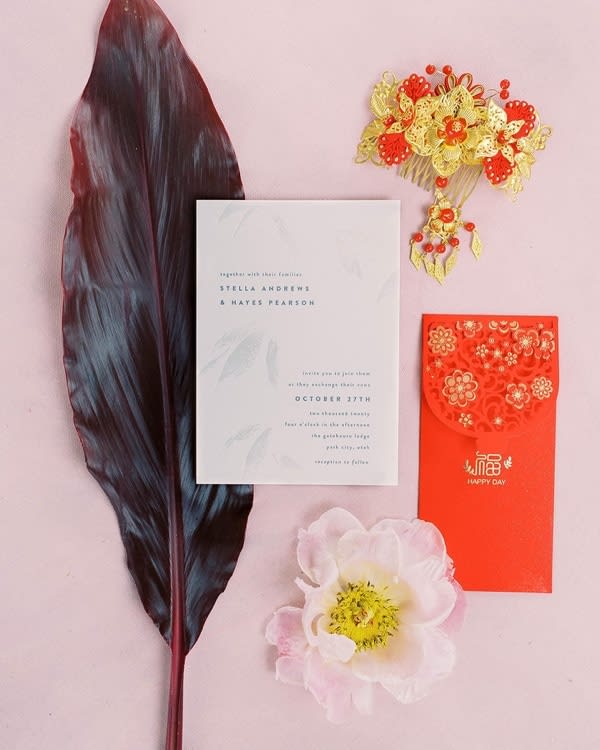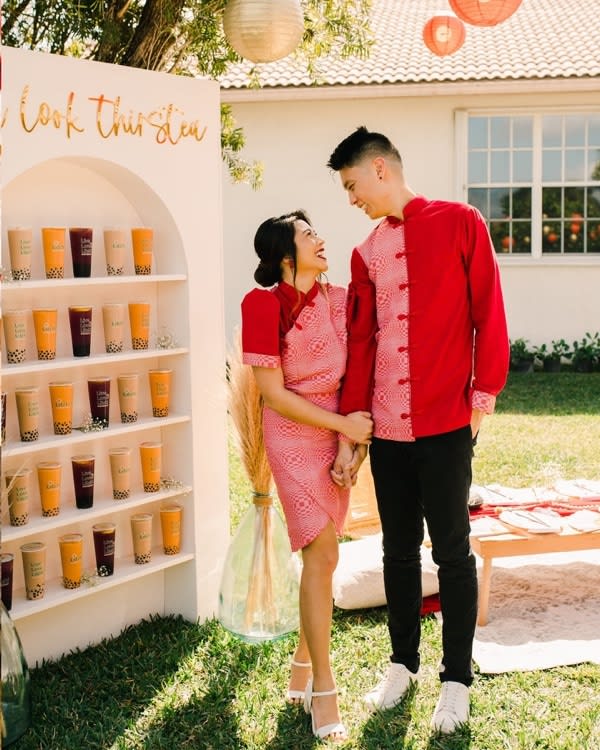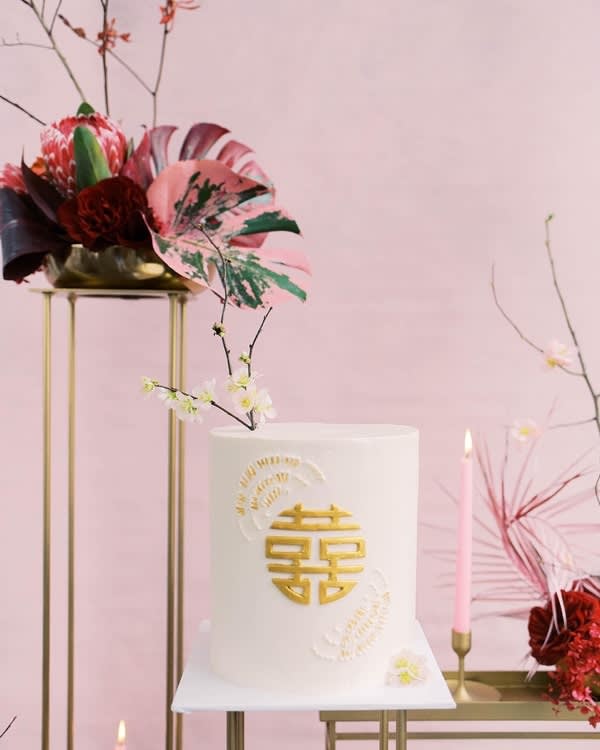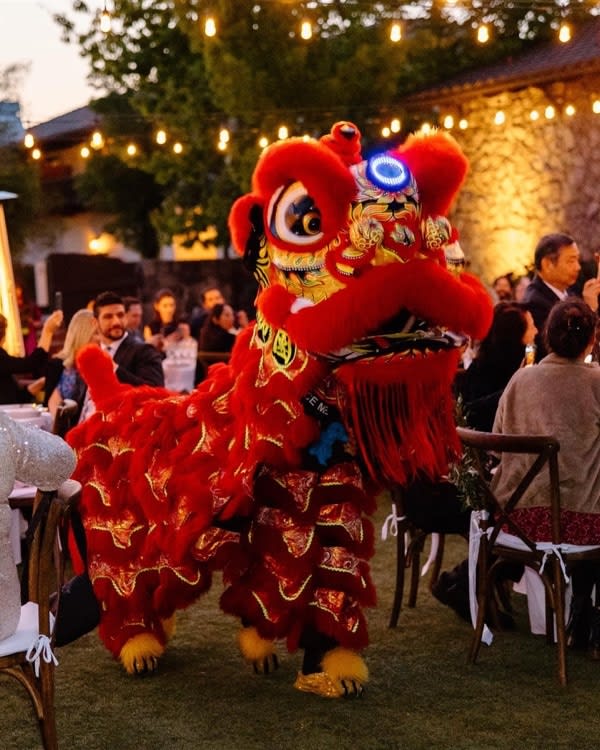A Chinese wedding is an extraordinary event full of tradition and symbolism. If you're planning on having a traditional Chinese wedding, there are some things you should know in order to make sure everything goes smoothly.
We'll review some beautiful Chinese wedding traditions so that you can be sure to include them on your big day.

Pre-Wedding Chinese Wedding Traditions
Pre-wedding Chinese wedding traditions are just as important as wedding traditions on the day of the wedding.
Invitations
The first step in any wedding is the invitation. In a traditional Chinese wedding, the wedding ceremony is hosted by the groom’s family. Thus, the groom’s family will send out invitations on behalf of the couple. The invitation will include the wedding's date, time, and location.
The color red (and gold), used for the invite, is considered very auspicious in Chinese culture and is thought to bring good luck.
In Chinese culture, the wedding date is chosen based on the Chinese lunar calendar. The calendar is used to determine which days are considered to be auspicious and which are not.

Photo: Mylyn Wood.
The Wedding Bed
After the invitations have been sent out and the wedding date has been chosen, it is time to prepare for the wedding bed. The wedding bed, also known as An Chuang, is considered to be one of the most important aspects of the Chinese wedding tradition. It is where the couple will consummate their marriage and start their life together.
The wedding bed is usually a simple bed with a red mattress and red pillows. The bedding is traditionally decorated with auspicious symbols such as dragons, phoenixes, and tigers.
The groom's family sets up the wedding bed a few days before the wedding. On the wedding day, the groom will carry the bride across the threshold of their new home and into the bedroom. Afterward, the bride will be given a sweet soup –consisting of red date, lotus seed, peanuts, and dried longan– to symbolize fertility and good luck.
Hair Combing Ceremony
The Hair Combing Ceremony is a traditional Chinese wedding ritual usually performed on the eve of the wedding day. The ceremony usually involves the bride's mother combing her hair and tying it up with a red ribbon. This ritual is no longer common as brides, nowadays, have professionals to do their hair. Some modern brides incorporate this tradition into their wedding day by having the mothers to just comb the brides’ hair in the beginning (just as a symbolism) and not having them do their hair entirely.
The fathers will then tie a red ribbon around the couple's wrists. The ceremony ends with the mothers giving the newlyweds a piece of advice. While performing this ritual, they will recite a Chinese litany: "May your union be blessed with good fortune, may you live in harmony, and may your love last forever."

Photo: AsiaWeddingNetwork.com.
The Procession & Picking Up the Bride
During the procession, the groom and his family will go to the bride's house to pick her up. They will be accompanied by a band playing traditional Chinese music and firecrackers. The bride will then be escorted to the groom's house by her parents.
Families with an affluent background will have a lion dance team often leading the procession. This traditional dance is done to ward off evil spirits while the lions are considered good luck symbols.
The double happiness symbol is also often seen during Chinese weddings. This symbol is believed to bring good luck to the newlyweds.
Door Games for the Groom (Chuangmen)
The chuangmen, or door games, are a series of fun challenges the groom must complete to be let into the wedding banquet. The idea is that their prized daughter will not just be given away — the groom will have to prove that he's worthy of her!
Some common chuangmen tasks include singing a love song, reciting poetry, answering riddles trivia questions about the bride, and performing a talent show. The groom will need to be creative to complete the challenges.
The ceremony is a great way to add fun and excitement to the wedding day and it’s a great opportunity for the groom to show off his sense of humor and quick wit. If the groom can complete all the tasks, he is welcomed into the banquet with open arms, followed by laughter from all the guests!

Chinese Wedding Ceremony Traditions
The Chinese wedding ceremony contains ancient traditions passed down from generation to generation. An important element that is woven and can be spotted throughout the ceremony is the double happiness symbol. This symbol is often seen at weddings and represents the union of two people. The double happiness symbol is usually displayed in red, considered a lucky color in Chinese culture.
The following are some other important Chinese wedding traditions.
Traditional Chinese Wedding Dress
The couple getting married usually wear traditional Chinese wedding outfits. The bride wears a red cheongsam or qipao dress because the color is considered to be sacred and chases away evil spirits in Chinese culture. The groom usually wears a black suit with a white shirt and may also wear a traditional Chinese jacket called a changshan.
The bride's hair is traditionally styled in a bun, and she might wear a veil over her face. The groom also wears a red scarf around his neck. After the ceremony, the couple will sometimes change into Western-style clothing where the bride wears a white dress, and the groom wears a black tuxedo.
Chinese wedding outfits are usually very intricate and beautiful. They are often adorned with embroidery, beads, and other decorations like the double happiness symbol mentioned above.

Tea Ceremony
The tea ceremony is one of the most important Chinese wedding traditions. It is a symbol of respect and appreciation for the couple's parents and elders in the family like grandparents, uncles, and aunties. During the ceremony, the couple will serve tea to their elders. They will usually kneel in front of them while doing this. The tea is served in small cups; it is considered disrespectful to refuse it.
After the couple has served the tea, they will receive gifts from the elders. The gifts are usually money or jewelry. The elders will also give the couple some wisdom for a happy and successful marriage.
The Exchange of Vows
The exchange of vows is another important part of the Chinese wedding ceremony. The couple usually kneels before their parents and says their traditional vows. They will then exchange rings and share a cup of wine. The wine is traditionally served in two cups connected with a red string. This symbolizes the union of two people.
After the exchange of vows, the couple will usually sign a marriage certificate at the venue or the government office. The witnesses and the parents usually sign the certificate. The parents will also give their blessing to the couple.

Photo: Danielle Margherite.
Wedding Gifts
Wedding gifts are usually given to the couple by their parents or relatives. The gifts are usually monetary, but they can also be in the form of jewelry or other valuable items. The gifts are often wrapped in red paper, as red is seen as a lucky color.
The bride's family will also give gifts to the groom's family. These gifts are usually in the form of food or household items. The purpose of these gifts is to show appreciation for the groom's family taking care of the bride.
Chinese wedding gifts are typically red envelopes and gold jewelry or accessories. The red envelope usually contains money for the couple to start a new life together after the celebration. It is adorned with designs and the double happiness symbol. On the other hand, gold jewelry is a valuable item in Chinese culture and is a perfect wedding gift for a new couple.
Chinese Wedding Banquet
The banquet is one of the most important aspects of a traditional Chinese wedding. This is where families and friends celebrate the new union with food, drink, and lots of fun! The bride and groom usually sit at the head table with their parents while guests are seated at round tables.
They typically serve 8-12 dishes during the banquet. Some of the most popular dishes served at Chinese weddings include Peking Duck, fish, and abalone. Each dish is carefully picked to symbolize good luck and blessings. All dishes will be placed at the center of the table, usually on a lazy susan. All guests on the table will share the dishFor example, fish is a must in a wedding banquet as, in Cantonese, the word “fish” sounds like “surplus”. Nowadays, as a result of the Western influence, it is also common to have a wedding cake in the reception.

Photo: Mylyn Wood.
Firecrackers and Lion Dancers
Another tradition during a Chinese wedding is the use of firecrackers and lion dancers. The firecrackers are believed to scare away evil spirits, and the lion dancers bless the new couple with good luck.
The lion dance is also a performance for guests to enjoy. The lion dance is done by trained professionals in this ancient Chinese art form.

Photo: Hannah Berglund Photography.
Umbrella or Rice Sieve
The rice sieve is an important part of the Chinese wedding ceremony. It symbolizes fertility and togetherness. The bride and groom will each take a handful of rice and place it in the sieve. They will then exchange vows and share a kiss over the rice. After the ceremony, the rice will be scattered around the wedding venue to bring good luck to the newlyweds.
Umbrellas are also used in Chinese weddings. They are a symbol of protection and are used to ward off evil spirits. The bride and groom will each hold an umbrella during the wedding ceremony. After the ceremony, they will open the umbrellas and walk under them together. This symbolizes their new life together and their commitment to protecting each other.
Post-Wedding Chinese Wedding Traditions
The following are traditions that take place after the wedding:
Tossing the Fan
According to Chinese custom, the bride would toss out a fan from the car to ward off evil spirits or bad luck. This gesture signifies that she is throwing away negative energy and emotions as she sets to begin a new life with her husband.
Post-Wedding Breakfast
The bride would prepare breakfast for her husband's family the day after the wedding. This is a way to show respect for the elders. After the bride had served breakfast, she would thank them for their help in preparing for the wedding. The elders would then present her with gifts as a form of blessing.

“Mizu Pattern” by Kanika Mathur.
Three Days after the Wedding
The newlywed couple would visit the bride's parents three days after the wedding. This is done to thank them for raising their daughter and ask for blessings. The couple would also visit the groom's grandparents.
After paying respects to elders, the newlyweds can go on their honeymoon.
Chinese Wedding Traditions for Bridesmaids
The bride will usually have several attendants or bridesmaids who assist her on her wedding day. In ancient times, these women were tasked with protecting the bride from evil spirits. Today, they are usually close friends or family members of the bride who play an important role in helping her prepare for the big day.
The number of bridesmaids a bride has is usually an even number, as odd numbers are considered unlucky in Chinese culture. The bridesmaids typically wear red or pink dresses, each carrying a small bouquet of flowers. They may also wear their hair in a traditional style known as chignon.
During the wedding ceremony, the bridesmaids will stand next to the bride and help her hold her veil. After the wedding ceremony, the bridesmaids will typically help the bride to change her outfit. They will also help her pack up her belongings and prepare for her honeymoon.

“Happiness X 2” by Melanie Kosuge.
Modern Chinese Wedding Traditions
Many modern Chinese or Asian-American couples today opt for a more Westernized wedding where the bride wears a white gown and the groom wears a suit. Other couples may have two ceremonies–one Western ceremony and one traditional Chinese Tea Ceremony. This is due to the influence of Western culture and practicality, as it may be difficult for some to attend a full-day wedding event.
Some couples choose to serve Western food, while others will have a mix of both Western and Chinese cuisine. It depends on the couple as they may want to incorporate both cultures into their wedding day.
They may also choose to hold their wedding ceremony overseas in countries such as Australia, France, or the United States, often included by where the couple may be working or studying. It may also be easier for family members who live overseas to attend the wedding if it is held in a location that is closer to them.
No matter how westernized the wedding is, many couples still incorporate traditional Chinese wedding elements into their big day as an expression of themselves and nod to their heritage, a beautiful representation of making a wedding day uniquely your own.

“Mizu Pattern” by Kanika Mathur.









































